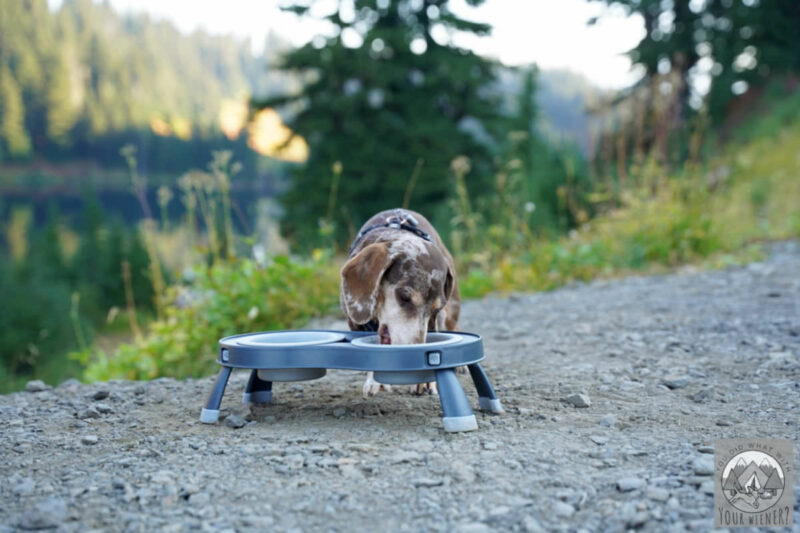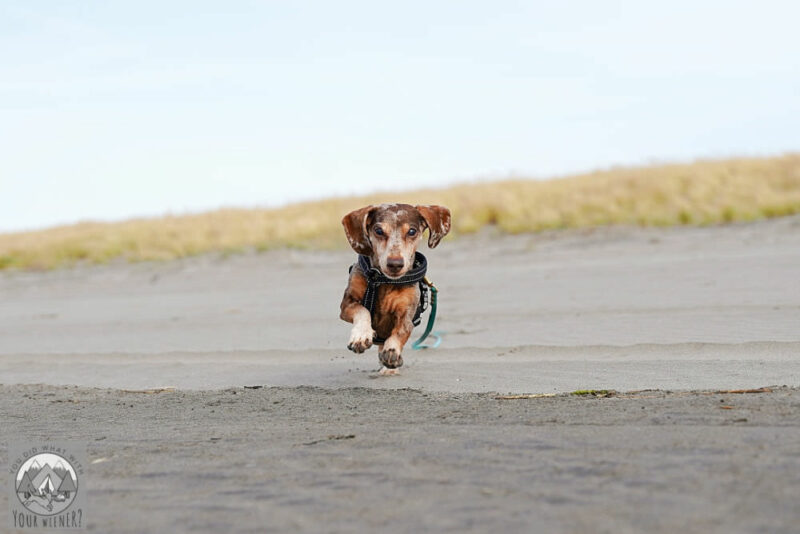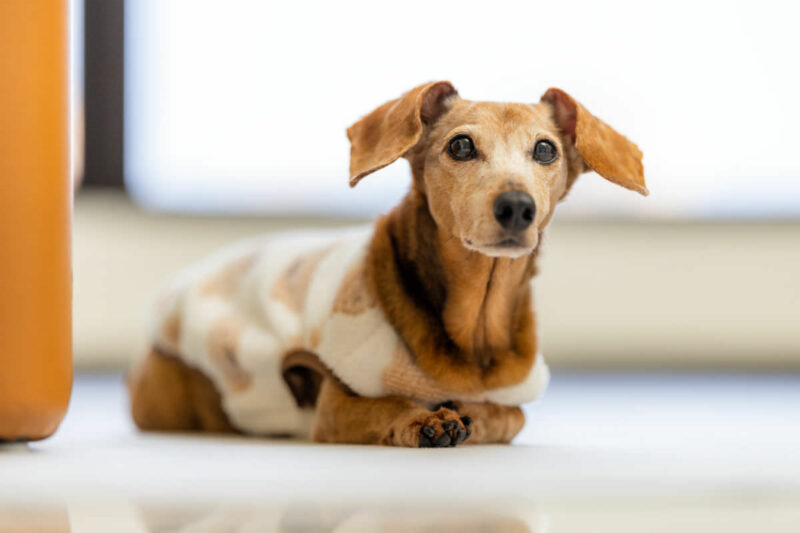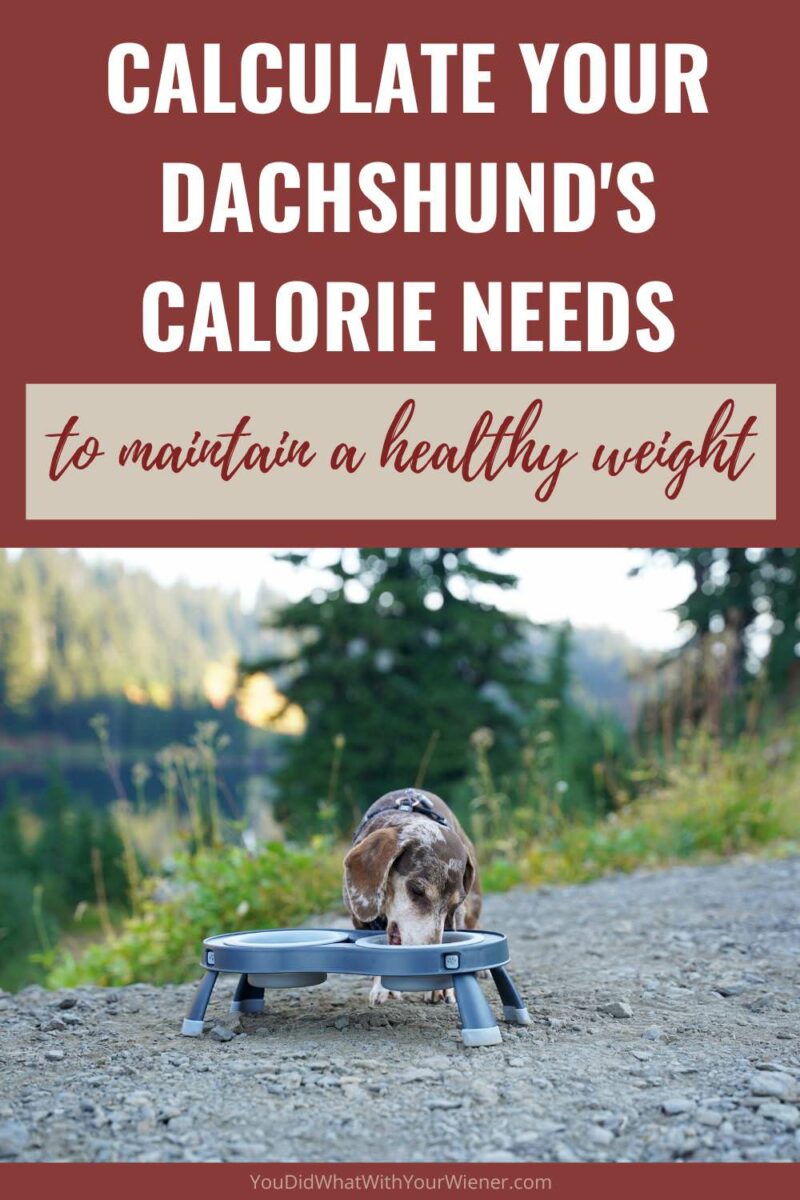How Many Calories Should a Dachshund Eat a Day?
Determining the number of calories your Dachshund should eat a day is the most important factor in determining what volume, or quantity, of food they should be eating.
Determining your dog’s calorie needs can be a complex process, as it depends on a variety of factors such as your dog’s weight (both current and ideal), age, and activity level.

In general, the more active a Dachshund is, the more calories they should eat a day to maintain their energy levels and support their overall health.
In the summer when we hike a lot, it’s very important for me to feed my Dachshunds enough calories so they have the energy to go the distance and don’t get too skinny.
In the winter when they are more sedentary, I need to recalculate their calorie needs, and adjust the amount of food and treats they eat, so they don’t get fat.
In this article, I explain how to determine how many calories your Dachshund needs to eat in a day, as well as some other important factors to consider when feeding your dog.
How to Calculate Calorie Needs Based on a Dachshund’s Activity Level
The first step in determining your Dachshund’s caloric needs is to consider their activity level and then do some simple math.
Dachshund’s who are highly active, such as those who participate in endurance sports or work as service dogs, will have a higher calorie requirement than dogs who are less active.
On the other hand, Dachshund’s who are less active or spend most of their time indoors may need fewer calories.
To determine a rough estimate of how many calories your Dachshund should eat a day, the following calculations can be used as a general guide:
The basic calorie needs calculation
The basic calculation is the simplest but also provides the most general results.
- Sedentary or less active dogs: 20 calories per pound of body weight per day
- Moderately active dogs: 30 calories per pound of body weight per day
- Highly active dogs: 40 calories per pound of body weight per day
For example, an 11-pound dog who is largely inactive (sedentary) would need approximately 220 calories per day (11 pounds x 20 calories per pound).
That same dog might need 440 calories (11 pounds x 40 calories per pound) during the summer if they are hiking a lot or participating in sports like agility, barn hunt, or Earthdog.

If you typically use metric units of measurement, you will need to convert your dog’s weight from kilograms to pounds first to use this calculation.
A more accurate calorie calculation
A more accurate way to determine your Dachshund’s caloric needs is to use their resting energy requirements (RER), which is the number of calories a dog needs to maintain their basic body functions at rest, and then use a multiplier based on their activity level.
To calculate a small dog’s RER, the following formula can be used:
RER = 70 x ((body weight in kilograms)^0.75)
Note: If you don’t remember how to do “to the power of” math like me, you can use this exponent calculator.
Typed in plain English, this calculation reads: Resting Energy Requirements (RER) equals the dog’s body weight in kilograms raised to the ¾ power then multiplied by 70.
As you can see for this calculation, you’ll need to convert your dog’s weight in pounds to kilograms.
Now, if you’re like me, math was not my strong suit and I learned it a long time ago so I prefer to use this handy calculator to get my dog’s RER.
Note: the bonus of this calculator is it takes your dog’s body condition score into account – more on that below.
According to this calculator, a 11-pound (5 kilograms) intact dog with a BCS of 5 would have an RER of approximately 220 calories per day.
Once your Dachshund’s RER has been determined, their total caloric needs can be calculated by taking into account how active they are.
To do this, a multiplication factor is used, corresponding to their activity level.
The following can be used as a general guide:
- Sedentary/ less active dogs or those that are spayed/neutered: RER x 1.6
- Moderately active or intact dogs: RER x 1.8
- Highly active dogs: RER x 2.0
- Extremely active working dogs : RER x 2-5 RER
For example, the 11-pound dog above, with an RER of 220 calories per day, would need approximately 396 calories per day if they were moderately active (220 x 1.8)
It’s important to note that these are rough estimates and may not be accurate for every dog.
As you can see, using the two different calculations yields slightly different results – 330 calories a day for a dog that is moderately active using the fist calculation vs 396 using the RMR x activity multiplier method.
Your dog’s real calorie needs will likely fall in between these two numbers but may lie at one end of that spectrum or just outside of it.
I know what you are thinking – “I came here for an actual answer.”
Unfortunately, since each dog is different, this is about as accurate as one can be because there are many other factors to consider.
Fine Tune Your Calculation Based on These Other Important Factors
Using the calculations above will give you an estimated range of calories your Dachshund should eat a day.
Now, you will want to adjust slightly up or down based on the factors below.
Body condition score (BCS)
A dog’s BCS is a measure of a dog’s body fat, with a score of 1 being extremely thin and a score of 9 being extremely overweight.
A dog with a BCS below 4 may be underweight and in need of more calories, while a dog with a BCS above 5 may be overweight and in need of fewer calories.
Remember to adjust the calorie calculation based on your dog’s ideal body condition score, not their current one if they are under (add a few calories) or overweight (reduce a few calories).

Age
Puppies and younger dogs need more calories due to their rapid growth and development.
As a dog gets older, their caloric needs may change due to a slower metabolism so older dogs may require fewer calories to maintain their weight
Neutered vs Intact
It’s known that spaying and neutering dogs can slow their metabolism.
Therefore, an “fixed” dog will likely need less calories to maintain their weight than a dog that has not had their growth hormones removed (intact, vasectomy, or ovary sparing spay).
Puppies and Nursing Mothers
Small breed puppies, and mothers nursing babies, need more calories in order to grow properly and produce enough milk, respectively.
Both could need between 30 and 50 additional calories a day per pound of body weight.
Overall health
Dachshunds with certain health conditions, such as diabetes, Cushing’s, or kidney disease, may have special caloric needs that need to be taken into account.
While it’s important to be aware of this, I don’t suggest you guess what adjustment you need to make on your own as it could have negative consequences.
It’s best to talk about your dog’s weight goals with your veterinarian as they can provide advice
based on your dog’s specific health concerns.
The Only Way to Truly Know if Your Dachshund is Eating the Right Amount of Calories
The only true way to know if you are feeding your dog the proper amount of calories is to go by their body condition score.
If your dog has a thick layer of fat over their ribs and you can’t see a tummy tuck or waistline, you will need to increase their exercise or feed them fewer calories per day, or both.
If your dog has little to no fat over their ribs and you can see their hip bones, you will want to increase the number of calories a little in order to maintain a healthy weight.
One note is that Dachshunds, although small, are considered a deep-chested breed and it’s normal to see the last rib or two.
If you want to learn more, read my article How Much Should My Dachshund Weigh?
Final Thoughts
Calculating how many calories a Dachshund should eat a day based on their activity level is important in order to make sure that they are getting the nutrients they need and don’t accidentally become under or over their optimum weight.
However, it’s also important to consider other factors when determining your Dachshund’s caloric needs, and adjust the results of your calculation up or down as needed based on your individual dog.
Remember, this is general advice intended to give you a good starting point.
It’s always a good idea to consult with a veterinarian or a professional canine nutritionist for specific calorie recommendations if you have questions.


About the Author
Hi, I’m Jessica. I’ve been studying the Dachshund breed since 2007, owned 3 of my own, and shared in the lives of thousands of others through their owner’s stories. When I’m not sharing what I know on this blog, you can find me hiking, camping, and traveling with my adventurous wiener dogs.
